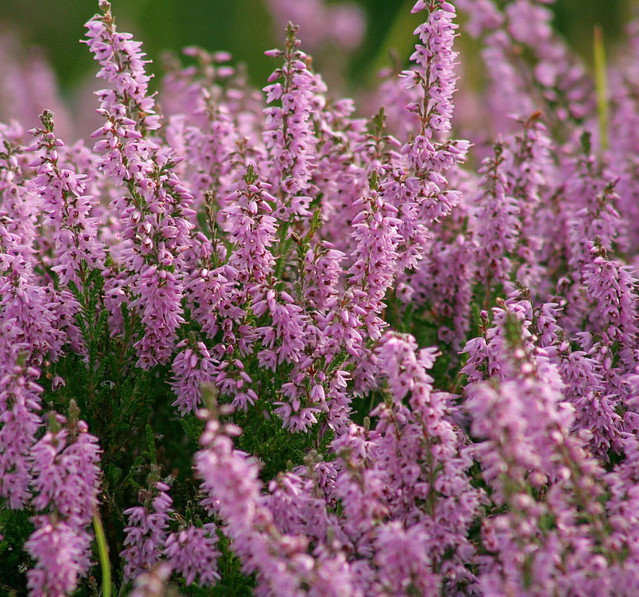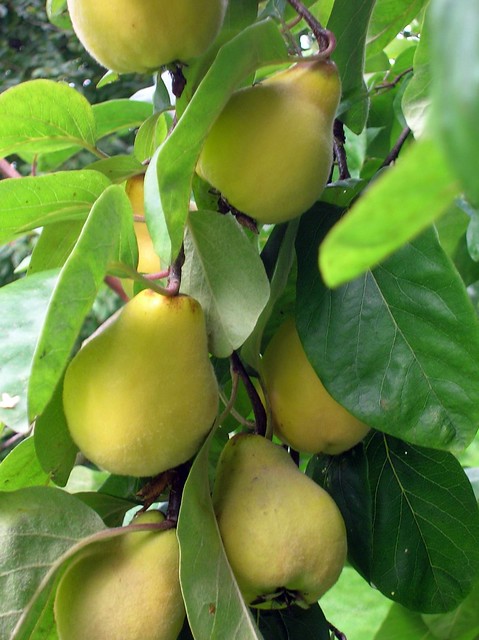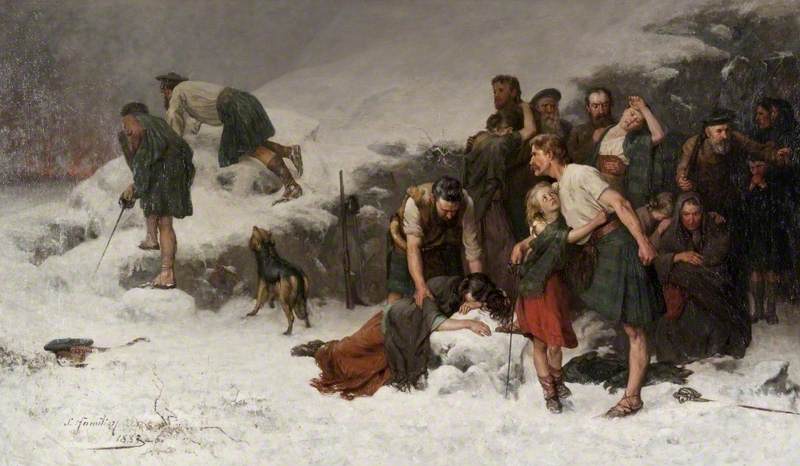Friday Fun Facts - 1/3/2014

Here are this week's Friday Fun Facts about Diana Gabaldon's books.

1) This is what heather (Calluna vulgaris) looks like when it's in bloom. (Photo credit: foxypar4, on Flickr.)
"Heather,” Roger said. “It’s more common in the summer, when the heather is blooming--then you’ll see heaps like that in front of every clan stone. Purple, and here and there a branch of the white heather--the white is for luck, and for kingship; it was Charlie’s emblem, that and the white rose.”
“Who leaves them?” Brianna squatted on her heels next to the path, touching the twigs with a gentle finger.
"Visitors.” Roger squatted next to her. He traced the faded letters on the stone--FRASER. “People descended from the families of the men who were killed here. Or just those who like to remember them.”
She looked sidelong at him, hair drifting around her face. “Have you ever done it?”
He looked down, smiling at his hands as they hung between his knees.
“Yes. I suppose it’s very sentimental, but I do.”
Brianna turned to the thicket of moor plants that edged the path on the other side.
“Show me which is heather,” she said.
(From DRAGONFLY IN AMBER by Diana Gabaldon, chapter 4, "Culloden". Copyright© 1992 by Diana Gabaldon. All rights reserved.)

From Wikipedia:
Heather is seen as iconic of Scotland, where the plant grows widely. When poems like Bonnie Auld Scotland speak of "fragrant hills of purple heather', when the hero of Kidnapped flees through the heather, when heather and Scotland are linked in the same sentence, the heather talked about is Calluna vulgaris.I like the story about heather found here:
The heather thought about the poor soil, the wind and the rain -- and wasn’t very sure that she could do a good job. But turning to God she replied that if he wanted her to do it, she would certainly give it a try.For more about heather, look here.
God was very pleased.
He was so pleased in fact that he decided to give the heather some gifts as a reward for her willingness to do as he had asked. Firstly he gave her the strength of the oak tree -- the bark of the heather is the strongest of any tree or shrub in the whole world. Next he gave her the fragrance of the honeysuckle -- a fragrance which is frequently used to gently perfume soaps and potpouris. Finally he gave her the sweetness of the rose -- so much so that heather is one of the bees' favourite flowers.
And to this day, heather is renowned especially for these three God given gifts.

2) The photo above shows a pair of dueling pistols, circa 1760. (Click on the photo for a bigger view.)
Someone spoke and he began to walk--he thought he was walking--until an outthrust arm stopped him, and he turned in answer to someone pointing urgently behind him.Lord John was obviously very familiar with the code duello, the rules that governed dueling. Here's an interesting article about the history of dueling.
Oh, hell, he thought wearily, seeing Nicholls’s arm come down. I don’t care.
He blinked at the muzzle flash—the report was lost in the shocked gasp from the crowd—and stood for a moment, wondering whether he’d been hit. Nothing seemed amiss, though, and someone nearby was urging him to fire.
Frigging poet, he thought. I’ll delope and have done. I want to go home. He raised his arm, aiming straight up into the air, but his arm lost contact with his brain for an instant, and his wrist sagged. He jerked, correcting it, and his hand tensed on the trigger. He had barely time to jerk the barrel aside, firing wildly.
(From "The Custom of the Army" by Diana Gabaldon, in A TRAIL OF FIRE. Copyright© 2010 by Diana Gabaldon. All rights reserved.)

3) This photo shows what quince jelly looks like. (Photo credit: Karen S. Burns-Booth at lavenderandlovage.com.)
"God, they did it in public,” he said, with a reminiscent shudder. “Two of them, on the table. Right between the saddle of mutton and the boiled potatoes. With the quince jelly.”
“Mon dieu,” said the newly returned maid, setting down the fresh bathcan long enough to cross herself.
“You be quiet,” I said, scowling at her.
(From DRAGONFLY IN AMBER by Diana Gabaldon, chapter 17, "Possession". Copyright© 1992 by Diana Gabaldon. All rights reserved.)

Quince (Cydonia oblonga) is a pear-like fruit, used to make jams, jellies, and marmalade. (Photo credit: br@mbly, on Flickr.) For more about quince, look here and here.

4) I had never heard of smooring a fire until I read Diana Gabaldon's books, but it's a very ancient custom. (Photo credit: Fashionable Frolick, on Flickr.)
You may remember Mrs. Bug's comments about smooring a fire, from A BREATH OF SNOW AND ASHES:
"Why, often I’ve spent an hour and more, trying to catch a spark in damp tinder--in Scotland, ’specially, since nothing’s ever dry in the winter there. Whyever d’ye think folk go to such trouble, a-smooring the fire?”The Carmina Gadelica lists four different blessings to be said when smooring a fire for the night: here, here, here, and here.
This caused a spirited discussion of the best way in which to smoor a fire for the night, including an argument over the proper blessing to be said while doing so, and this lasted long enough for me to have coaxed the brazier into a decent glow and set a small kettle in it for tea-making.
(From A BREATH OF SNOW AND ASHES by Diana Gabaldon, chapter 35, "Laminaria". Copyright© 2005 by Diana Gabaldon. All rights reserved.)

5) This painting, "The Massacre of Glencoe", by 19th-century artist James Hamilton, depicts the aftermath of the massacre that took place on February 13, 1692, when the surviving members of the MacDonald clan fled for their lives in the middle of a snowstorm.
"Well, that's verra sound reasoning on your part, Sassenach," he said, sounding mildly surprised that I was capable of reason. "Or would be," he added, "did Colum not have guards posted all round the castle and scattered through the woods. He'd hardly leave the castle unprotected, and the fighting men of the whole clan inside it. Granted that stone doesna burn so well as wood..."
I gathered he was referring to the infamous Glencoe Massacre, when one John Campbell, on government orders, had put thirty-eight members of the MacDonald clan to the sword and burned the house above them. I calculated rapidly. That would have been only fifty-some years before; recent enough to justify any defensive precautions on Colum's part.
(From OUTLANDER by Diana Gabaldon, chapter 10, "The Oath-Taking". Copyright© 1991 by Diana Gabaldon. All rights reserved.)
This photo, from Wikipedia, shows the memorial to the victims of the massacre.
You may be familiar with the song, "The Massacre of Glencoe". I like this version, sung by John McDermott, because of the gorgeous views of the scenery around Glencoe. (You can see the lyrics here.)
I hope you enjoyed these Friday Fun Facts! Look here to see all of my Friday Fun Facts blog posts, and please come back next week for more!







I've been enjoying your blog. I read through the Outlander series three years ago and have been re-reading Book 1 in preparation for the series. And I must say, I'm enjoying it so much more the second time through. I'm reading it slower and really savoring Diana's writing. I've said in my reviews of her books that each one was better than the last. Now I may have to re-read them all again - something I normally don't do with a book.
Karen Charbonneau
Author: The Wolf's Sun